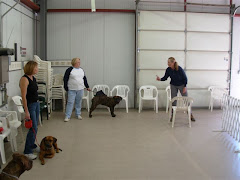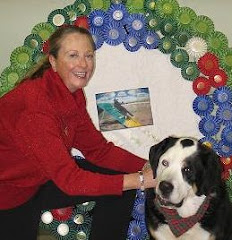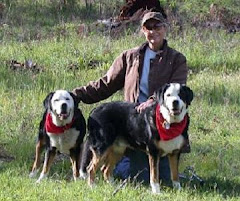 Dogs have phobias and irrational fears, just like we do. Maybe it's the bell on the toaster oven that sets them off. Maybe it's the sight of the vacuum cleaner. Or the sound of a gunshot. Or a man in a baseball cap. There's usually no telling where or how the fear started, but you can predict that the fear will feed on itself and escalate over time, until your dog is potentially afraid of much more than the initial trigger.
Dogs have phobias and irrational fears, just like we do. Maybe it's the bell on the toaster oven that sets them off. Maybe it's the sight of the vacuum cleaner. Or the sound of a gunshot. Or a man in a baseball cap. There's usually no telling where or how the fear started, but you can predict that the fear will feed on itself and escalate over time, until your dog is potentially afraid of much more than the initial trigger.What are you afraid of? Spiders? Electrical storms? We're not talking about DISLIKING something. We're talking about something that makes you queasy and sweaty just thinking about it. Something that you KNOW can't actually hurt you...but for some strange reason, you're afraid to face the fear and work through it....so you avoid the situations that involve the triggers. Sometimes if left unchecked, more and more triggers develop, until you're consumed by fear and afraid to leave your house.
The dog who's riddled with fears isn't living a happy life. He's perpetually stressed. This can lead to all sorts of other problems like fear biting, gastric upsets and even seizures. What starts out as a simple "She's afraid of the dishwasher" can potentially snowball into debilitating illness.
Volumes have been written on helping dogs (and people) overcome fears and phobias. In my own experience of many years and countless dogs, I favor the technique known as "flooding." It may not be appropriate for every case, but the vast majority can be helped this way. It's physically painless, it's fast, and it involves engaging the BRAIN by overcoming emotion with intellect.
Here's a crude example of how "flooding" works for people. A person with a fear of spiders has a jar of harmless spiders emptied on him. He has to sit there and learn to relax while the spiders crawl all over him. I imagine the first few seconds or minutes would be quite terrifying, but the man is using his intellect to overcome the fear. He's not being hurt. After a few minutes, he becomes desensitized to the spiders and learns to overcome the emotional, fear-ridden response. He may even become curious about them as he further relaxes and realizes that he is in the position of dominance and control. He has dominion over the object he once feared, and he controls his own emotions and life.
Desensitizing a dog through "flooding" may take on this scenario:
The dog is afraid of a corner of the room, for whatever reason. The dog wants to avoid walking near that corner of the room and will try anything to keep from doing so. If she's on a leash and you walk her toward the dreaded corner, she'll tug back, do somersaults, skid sideways, and pee on herself as she tries to avoid going near that spot. You, as therapist, don't acknowledge her fear in any way. You start a distance away from the spot and walk her (restraining her at your side on a short leash) past it. Turn around and do the same. Walk back and forth, briskly and confidently with her, without looking toward "the spot" and without acknowledging her antics. As you feel her start to relax at this safe distance, praise her with upbeat confidence and keep going. Work closer and closer to the spot, taking your time and using as many repetitive trips as necessary, until you feel her fear begin to diminish. Do not acknowledge "the spot." It is of NO consequence to you, and that's what you're projecting to her. If you the leader aren't afraid of it, she need not be afraid of it either. Eventually you'll be sitting down on the floor with her, playing tug and fetch, wrestling, and whatever, in the spot she once dreaded. With light maintenance over the next several days, weeks or even months, you can keep her from reverting back to her formerly fearful state.
Watching a fearful dog being "flooded" is usually more painful for the onlookers than for the dog itself. We project our own emotions into these situations. We empathize, we "imagine what the poor dog must be going through" as we watch the dog struggle to get away from the dishwasher, the toaster oven, the man in the baseball cap, or whatever we're requiring him to face.
Trust your therapist
Before your fearful dog is able to cooperate with the you (the therapist), he first must TRUST you. Trust can be developed quickly, as in a matter of seconds. It's not about love and affection and words of comfort. It's about coming face to face in a sudden crisis with someone who obviously is:
1. Stronger than you
2. Smarter than you
3. More confident than you
4. Projecting a positive energy
The quickest way for you to reestablish trust in your fearful dog is the "neck massage" that all my beginning students do the first week of class--and whenever necessary thereafter. This is the restraint exercise where you hold the dog's head securely in your hands and turn his face upward toward yours, as you stand (not kneel) above him. The dog may struggle at first and tune you out. Ultimately, he'll relax in your hands as his brain opens up and he transforms from a "reactive" state to a "thinking" state. You establish mesmerizing eye contact with him, and he realizes that you've taken control of him without hurting him in any way. This, in itself, is a type of "flooding" that sets the stage for working your dog through any fears may follow.
Now, as you walk your trusting dog into the fearful situation, the dog puts his trust in you and learns to concentrate more on his therapist-handler than on the scary spot. It's like someone talking a "leaper" off a window ledge. He'll tell the leaper not to look down, and to establish contact with him instead. He'll gain the leaper's trust, get his mind off the situation at hand, engage him in conversation to get his brain working with logic and intellect rather than emotion.
So what WAS your phobia? Mine was doing somersaults in gym class. God only knows why, but to this day I can't bear the thought of getting down on the floor and doing a "forward roll." I did it twice...enough to keep from getting an "F" in class. The gym teacher, whom I hated, finally got me into the position and just PUSHED ME OVER. My first response was "Ohmygosh, is that all there is to it?" She did it once more and passed me on the exercise. She probably should have done it about 20 more times. If she had, I would have gotten over that phobia. Because I didn't, I was never able to do cartwheels and all those other fun, carefree things that kids do in the summer grass. I haven't exactly lived a dull life, but I can't help but wonder how my life would have been a bit different if I'd been able to do somersaults!


















No comments:
Post a Comment